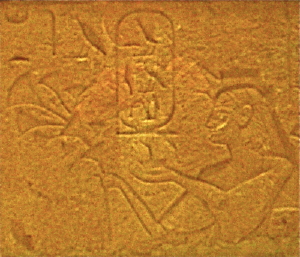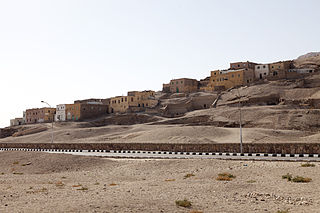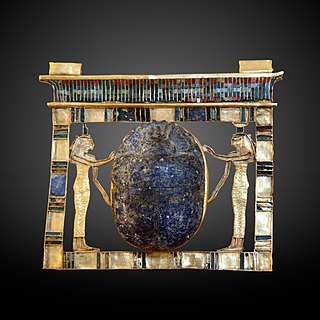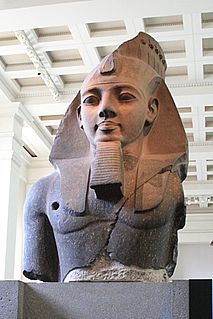Related Research Articles

Memphis or Men-nefer was the ancient capital of Inebu-hedj, the first nome of Lower Egypt that was known as mḥw ("north"). Its ruins are located near the modern town of Mit Rahina, 20 km (12 mi) south of Giza in Greater Cairo, Egypt.

Saqqara, also spelled Sakkara or Saccara in English, is an Egyptian village in Giza Governorate, that contains ancient burial grounds of Egyptian royalty, serving as the necropolis for the ancient Egyptian capital, Memphis. Saqqara contains numerous pyramids, including the Step pyramid of Djoser, sometimes referred to as the Step Tomb, and a number of mastaba tombs. Located some 30 km (19 mi) south of modern-day Cairo, Saqqara covers an area of around 7 by 1.5 km.

Nefertari, also known as Nefertari Meritmut, was an Egyptian queen and the first of the Great Royal Wives of Ramesses the Great. She is one of the best known Egyptian queens, among such women as Cleopatra, Nefertiti, and Hatshepsut, and one of the most prominent not known or thought to have reigned in her own right. She was highly educated and able to both read and write hieroglyphs, a very rare skill at the time. She used these skills in her diplomatic work, corresponding with other prominent royals of the time. Her lavishly decorated tomb, QV66, is one of the largest and most spectacular in the Valley of the Queens. Ramesses also constructed a temple for her at Abu Simbel next to his colossal monument there.

Heqamaatre Setepenamun Ramesses IV was the third pharaoh of the Twentieth Dynasty of the New Kingdom of Ancient Egypt. He was the second son of Ramesses III and crown prince when his elder brother Amenherkhepshef died aged 15 in 1164 BC, when Ramesses was only 12 years old. His promotion to crown prince:
is suggested by his appearance in a scene of the festival of Min at the Ramesses III temple at Karnak, which may have been completed by Year 22 [of his father's reign].

Usermaatre Setepenre Meryamun Ramesses VII was the sixth pharaoh of the 20th Dynasty of Ancient Egypt. He reigned from about 1136 to 1129 BC and was the son of Ramesses VI. Other dates for his reign are 1138–1131 BC. The Turin Accounting Papyrus 1907+1908 is dated to Year 7 III Shemu day 26 of his reign and has been reconstructed to show that 11 full years passed from Year 5 of Ramesses VI to Year 7 of his reign.

The necropolis of Draʻ Abu el-Naga' is located on the West Bank of the Nile at Thebes, Egypt, just by the entrance of the dry bay that leads up to Deir el-Bahari and north of the necropolis of el-Assasif. The necropolis is located near the Valley of the Kings.

The necropolis of El-Khokha is located on the west bank of the river Nile at Thebes, Egypt. The necropolis is surrounds a hill and has five Old Kingdom tombs and over 50 tombs from the 18th, 19th and 20th dynasties as well as some from the First Intermediate Period and the Late Period.

Tuya was the wife of Pharaoh Seti I of the Nineteenth Dynasty of Egypt and mother of Tia, Ramesses II, and perhaps Henutmire.

Qurnet Murai is a necropolis located on the West Bank of the Nile at Thebes, Egypt, just to the south of Sheikh Abd el-Qurna.

The ancient Egyptian Noble Paser was vizier in the reigns of Seti I and Ramesses II, during the 19th Dynasty. He would later also become High Priest of Amun.

Setau was the Viceroy of Kush in the second half of Ramesses II's reign. Contemporary records show that Setau served in this position from Year 38 until at least Year 63 of Ramesses II's reign. Setau was "a graduate of the royal school" and already enjoyed an impressive record of royal service which is detailed in a long autobiographical inscription carved at Wadi es-Sebua. The temple of Wadi es-Sebua was built for Ramesses II by Setau around 1236 BC or Year 44 of this pharaoh's reign. Eleven of his stela, now in the Cairo Museum, were found in the courtyard of this temple and make it possible to establish his career and understand the precise duties of a viceroy. Setau states:
I was one whom his Lord caused to instructed....as a ward of the palace. I grew up in the royal abode when I was a youth...I was provided for with bread and beer from all the royal meals. I came forth as a scribe from the school, I was appointed to be Chief Scribe of the Vizier; I assessed the whole land with a scroll. A task I being equal to the task.

Ramesses II, commonly known as Ramesses the Great, was the third pharaoh of the Nineteenth Dynasty of Egypt. Along with Thutmose III he is often regarded as the greatest, most celebrated, and most powerful pharaoh of the New Kingdom, itself the most powerful period of Ancient Egypt.

Pahemnetjer(p3-ḥm-nṯr; "servant of the god", "priest") was a High Priest of Ptah during the reign of Ramesses II. Pahemnetjer succeeded Huy as High Priest of Ptah and was in turn succeeded by his son Didia.

The ancient Egyptian noble Prehotep II was Vizier in the latter part of the reign of Ramesses II, during the 19th Dynasty.

QV80 is the tomb of (Mut-)Tuya, the Great Royal Wife of Seti I, and the mother of Ramses II, in Egypt's Valley of the Queens.

Tia was an ancient Egyptian high official under king Ramses II. His main title was that of an overseer of the treasuries. Tia was married to a woman with the same name, the princess Tia who was sister of Ramses II.
Mahu was an ancient Egyptian official who was in office under king Ramses II. He is mainly known from his monumental tomb excavated at Saqqara.
Suty was a high official under the Ancient Egyptian king Ramses II. He was overseer of the treasuries and overseer of troops. As overseer of the treasuries he was responsible for the administraion of the commodities coming to the royal palace. Suty is known from his decorated tomb at El Khawaled (Mostagedda), in Upper Egypt. He is also known from a sarcophagus that is now in the Egyptian Museum at Cairo but most likely comes from this tomb. Shabtis with his name were found in burials of the Apis bulls at Saqqara. They were found close to Apis bulls that were buried in the year 16 and year 30 of the reign of Ramses II. In year 24 a certain Panehesi was in offices as overseer of the treasuries, before the latter Tia occupied this office, so that Suty must have been in office around year 30 of king Ramses II. This also indicates that Suty was involved in preparing the burials of these sacred animals. He is also known from several statues.

Tjuneroy was an Ancient Egyptian official under king Ramses II in the 19th Dynasty. Tjuneroy is mainly known from objects found in his tomb at Saqqara. He came from an influential family. His father Paser (I) was royal scribe and was working for the Amun temple. His brother Paser (II) was again royal scribe but was also overseeing royal building works. The tomb chapel of Tjuneroy was once decorated with reliefs that are now in the Egyptian Museum in Cairo. One wall in the tomb chapel was decorated with a king list that is known as the Saqqara Tablet. Tjuneroy is also known from fragments of a door frame found at Pi-Ramesses indicating that he lived there. His titles include chief lecture priest and overseer of all royal works.
References
- 1 2 Alberge, Dalya (2 September 2022). "Archaeologists hail 'dream discovery' as sarcophagus is unearthed near Cairo". The Observer. Archived from the original on 2 September 2022. Retrieved 2 September 2022.
- ↑ Staring, Nico (2016). "The Tomb of Ptahemwia at Saqqara". Journal of Egyptian Archaeology. 102: 145–170. Archived from the original on 2022-05-25. Retrieved 2022-10-03.
- ↑ Staring, in: Journal of Egyptian Archaeology 102 (2016), 157-158 (the object is today in the Cairo Egyptian Museum, JE 8371); Karol Myšliwiec: Zwei Pyramidia der XIX Dynastie aus Memphis, in: Studien zur altägyptischen Kultur 6 (1978), 139-15, plates XXXVI-XXXVII
- ↑ Kitchen, Kenneth A. (2001). Ramesside Inscriptions, Translated and Annotated Translations: Ramesses II, His Contemporaries (Ramesside Inscriptions Translations). Vol. III. Wiley-Blackwell. pp. 273–274. ISBN 978-0631184287.
- ↑ "Archaeologists unveil the tomb of Ramesses II's scribe". Heritage Daily - Archaeology News. 9 November 2021. Archived from the original on 2 December 2021. Retrieved 3 October 2022.
- ↑ Samaan, Magdy (31 October 2021). "Tomb of Ptahemwia, scribe to Ramses the Great, found near Cairo" . The Times. Archived from the original on 20 November 2021. Retrieved 1 November 2021.
- ↑ el Aguizy, Ola (2022). "Latest Discories at Saqqara". Egyptian Archaeology. 60: 48–49. Archived from the original on 2022-07-21. Retrieved 2022-10-02.